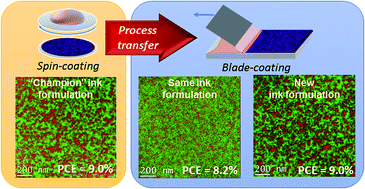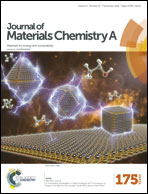Highly efficient polymer solar cells with printed photoactive layer: rational process transfer from spin-coating†
Abstract
Scalable and continuous roll-to-roll manufacturing is at the heart of the promise of low-cost and high throughput manufacturing of solution-processed photovoltaics. Yet, to date the vast majority of champion organic solar cells reported in the literature rely on spin-coating of the photoactive bulk heterojunction (BHJ) layer, with the performance of printed solar cells lagging behind in most instances. Here, we investigate the performance gap between polymer solar cells prepared by spin-coating and blade-coating the BHJ layer for the important class of modern polymers exhibiting no long range crystalline order. We find that thickness parity does not always yield performance parity even when using identical formulations. Significant differences in the drying kinetics between the processes are found to be responsible for BHJ nanomorphology differences. We propose an approach which benchmarks the film drying kinetics and associated BHJ nanomorphology development against those of the champion laboratory devices prepared by spin-coating the BHJ layer by adjusting the process temperature. If the optimization requires the solution concentration to be changed, then it is crucial to maintain the additive-to-solute volume ratio. Emulating the drying kinetics of spin-coating is also shown to help achieve morphological and performance parities. We put this approach to the test and demonstrate printed PTB7:PC71BM polymer solar cells with efficiency of 9% and 6.5% PCEs on glass and flexible PET substrates, respectively. We further demonstrate performance parity for two other popular donor polymer systems exhibiting rigid backbones and absence of a long range crystalline order, achieving a PCE of 9.7%, the highest efficiency reported to date for a blade coated organic solar cell. The rational process transfer illustrated in this study should help the broader and successful adoption of scalable printing methods for these material systems.


 Please wait while we load your content...
Please wait while we load your content...